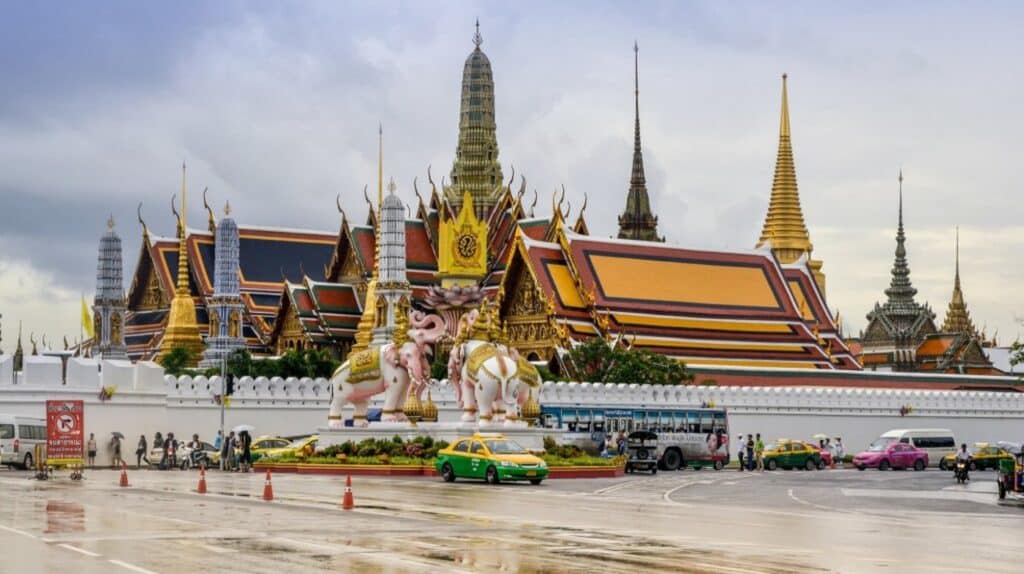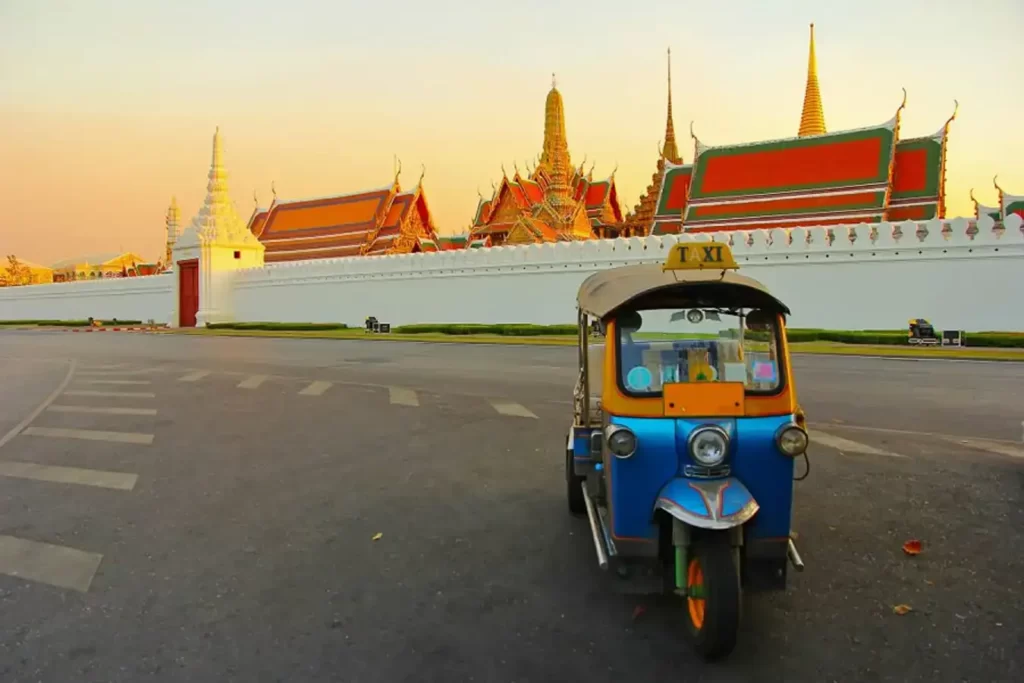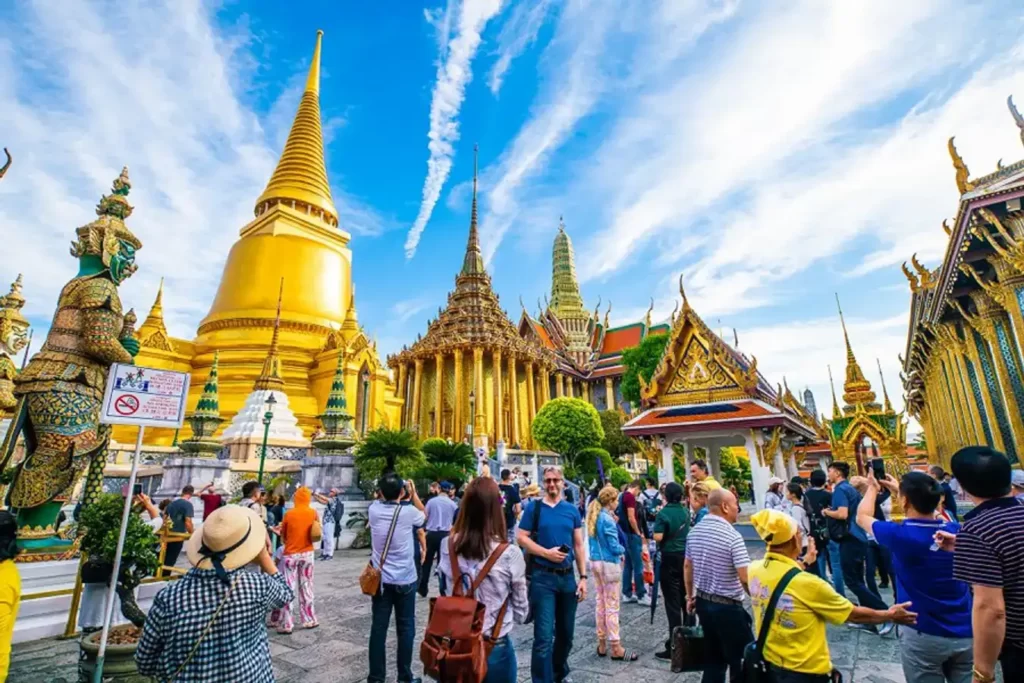Thailand is not just renowned for its breathtaking landscapes and rich culinary delights, but also for its magnificent temples that exude an aura of classic grandeur and solemnity. Among these countless sacred architectural works, Wat Phra Kaew is considered one of three national treasures. In this article, LotusBuddhas will help you discover the nuances and charms of this globally famous Thai temple.
Introducing Wat Phra Kaew Temple
Where is Wat Phra Kaew Temple located?
- Address: QF2V+M34, Na Phra Lan Rd, Khwaeng Phra Borom Maha Ratchawang, Khet Phra Nakhon, Krung Thep Maha Nakhon 10200, Thailand.
Wat Phra Kaew, also known as the Temple of the Emerald Buddha, is situated within the precincts of the Grand Palace in the historic center of Bangkok, Thailand. This temple complex is located in the Phra Nakhon District, on the banks of the Chao Phraya River, making it a prominent and easily accessible landmark in the capital city.
Temple of the Emerald Buddha is surrounded by a long wall, serving not only as a barrier to maintain the serenity and peace inside but also as protection for the temple’s sanctity. When you step into Wat Phra Kaew, no matter how bustling and noisy the world outside may be, you’ll find a haven of tranquility that touches the depths of your soul.
The rationale behind these fortified walls goes beyond just protection. Historically, the Thai royalty believed that if the ancient and precious statue inside the temple was stolen, it signified the downfall of their reign. Therefore, the construction of such a sturdy wall was imperative to safeguard the revered Emerald Buddha inside.
Within the palace grounds, you’ll encounter hundreds of temples, large and small. However, the most prominent among them is Wat Phra Kaew, known for its grandeur and magnificence. Its full name is Phra Si Rattana Satsadaram. The temple’s fame doesn’t only stem from its distinctive architectural beauty but also from the sacred Emerald Buddha statue it houses. Unlike many temples, Wat Phra Kaew doesn’t have living quarters for monks. Instead, it boasts intricately decorated buildings. Historically, only the King was allowed to visit, and no one else could enter the temple grounds.
History is closely linked to the journey of the Emerald Buddha statue
The temple’s origins can be traced back to the late 18th century, when King Rama I, the founder of the Chakri Dynasty, moved the capital of Thailand from Thonburi to Bangkok. He initiated the construction of the Grand Palace, and within its complex, he ordered the building of Wat Phra Kaew to house the Emerald Buddha, a revered green statue made of jade or jasper rather than actual emerald.
The history of the Emerald Buddha itself predates the temple. Legend has it that the statue was crafted in India around 43 BC, though its exact origins are shrouded in mystery. Over the centuries, the Emerald Buddha traveled throughout Southeast Asia, residing in various temples in Cambodia, Laos, and Thailand. Before its current home in Bangkok, the statue was housed in Vientiane, the capital of Laos. When King Taksin and later King Rama I of Thailand defeated Vientiane, the statue was brought to its present location.
Over the years, subsequent Thai kings have made additions and renovations to the temple, each contributing to its splendor. King Rama III, for instance, added a library known as the “Phra Mondop” and the model of Angkor Wat, reflecting the historical connections between Thailand and Cambodia.
Beyond its historical significance, the Temple of the Emerald Buddha holds deep spiritual importance for the Thai people. The Emerald Buddha is dressed in seasonal costumes, which are changed by the Thai king or his representative in a ceremony at the changing of the seasons – a tradition that has been followed for centuries and symbolizes the close relationship between the Thai monarchy and the temple.
Tourists and pilgrims from all over the world visit Wat Phra Kaew each year, not just to witness its historical and artistic splendor, but also to pay respects to the Emerald Buddha, a symbol of the Thai nation’s soul and spirit.
The Emerald Buddha Temple has majestic architecture no different from a palace
Clad in dazzling gold, Wat Phra Kaew catches your eye from afar, often making first-time visitors imagine they’re approaching a grand palace. This spiritual complex boasts around 100 ornate towers, each exquisitely detailed, as if telling tales from the past.
Spanning over 900,000 square meters, it’s no surprise that Wat Phra Kaew ranks among the largest and most impressive temples in the land of a thousand temples, Thailand. What sets this temple apart is the absence of monk residences; instead, you’ll find towers and a main hall reserved for the royalty and visitors.
Encircling the temple is a 1km long wall adorned with 170 mural paintings depicting heroic battles from the Ramakien era. These murals are meticulously crafted, each stroke capturing the essence of the tale, giving you a glimpse into the temple’s scale and grandeur.
The Royal Pantheon is another highlight, housing statues of the seven powerful kings from the Rama I to Rama VII dynasties. Notably, this tower only opens its doors annually on the 6th of April.
Within the main grounds, you’ll notice structures with distinct Thai Buddhist architectural features: towers with spires piercing the blue skies, all fashioned in the Rattanakosin style.
Also, within the temple grounds stand two elephant statues donned in white with intricate patterns, symbolizing independence and power for the Thai people. Traditionally, it was believed that parents should carry their children around these statues for a future filled with strength and success. Nearly every wall of Wat Phra Kaew is covered with captivating and meaningful historical narratives.
As you walk into the corridor of the Temple of the Emerald Buddha, the towering statues of the guardian deities, Yaksa Tavarnbal, standing over 5 meters tall, greet you at the entrance. Furthermore, the temple grounds house two libraries storing scriptures and the relics of the Buddha within the Phra Si Rattana Chedi.
How to get to Wat Phra Kaew temple
If you’re keen on visiting the sacred Wat Phra Kaew, you can head to Na Phra Lan, Pranakorn, located within the Royal Palace grounds in the Old City (Rattanakosin) area of Bangkok. There are several transportation options available to reach the Temple of the Emerald Buddha:
- River Taxi: One of the most cost-effective and scenic ways to reach the temple is by taking a river taxi. You can board these boats at the Tha Chang pier. Simply tell the boat driver you wish to visit Wat Phra Kaew, and they will take you there.
- Road Taxi: For a more direct and faster route, consider hailing a taxi. To book one, you can contact +66 26623 5500, and they will drive you straight to the temple.
- Tuk Tuk: Embrace a traditional Thai experience by hopping onto a tuk-tuk, a popular mode of transportation in Thailand. You can find tuk-tuks at various spots around the city and ask the driver to take you to Wat Phra Kaew.
- Bus: Lastly, public buses are also an option. Several bus routes pass by the temple, including numbers 1, 35, 44, 47, 123, and 201. If you opt for the bus, make sure to check the schedule to avoid missing one or facing delays.
Regardless of which means of transportation you choose, Temple of the Emerald Buddha is a destination not to be missed when you travel to Bangkok. Why did LotusBuddhas say that? Because this temple represents Thailand’s rich culture and heritage.
The Emerald Buddha in Wat Phra Kaew
Features of the Emerald Buddha statue
The Emerald Buddha statue is the most exceptional, treasured, and sacred artifact within Wat Phra Kaew. Currently, it is enshrined in the main hall of Wat Phra Kaew. The Thai people hold this statue in the highest regard, considering it a national treasure. They meticulously care for and preserve it.
The statue stands at about 70cm tall, displaying a mesmerizing jade-green hue, and it emits a peculiar radiance. To the Thais, the light that emanates from the statue symbolizes the shining aura of joy and faith. The Emerald Buddha is posed in the Dhyana Mudra meditation position, seated atop a pristine lotus pedestal.
You can find the Emerald Buddha elevated on an 11-meter-high golden altar. From a distance, you can witness its brilliant luminance, not just from its inherent glow but also its overall majestic demeanor. Glass orbs are placed on either side of the statue, representing the sun and moon.
Made of pure jade, the Emerald Buddha in Wat Phra Kaew is profoundly revered and respected by the Thai people. As such, its attire is ceremoniously changed three times a year, coinciding with the hot season, rainy season, and cool season. During the hot season, the statue is adorned with the crown and scepter of the Ayutthayan King. In the rainy season, the Emerald Buddha is draped in a thin gold robe. Come the cool season, the Buddha dons a full monk’s robe and hat. This ritual is not only a testament to the deep respect the Thais have for the statue but also an embodiment of the cultural significance it holds in their hearts.
The Sacred story of the Emerald Buddha statue
The story of the Emerald Buddha is shrouded in legend, mystery, and reverence. Its origins trace back to India, the birthplace of Buddhism, where, according to lore, a sage named Nagasena prophesied in 43 BCE that a great Buddha statue would be created, bringing prosperity and peace wherever it resided.
After its creation, the statue traveled far and wide. It is said to have been in Sri Lanka for protection from a civil war and later was taken to Cambodia in the 5th century, then Ayutthaya, an ancient Thai kingdom, in the 10th century.
Its name, “Emerald Buddha,” doesn’t refer to the stone from which it is carved – which is jade or jasper – but rather to its striking green color. The statue is relatively modest in size, standing only about 66 cm tall, but its spiritual significance is immeasurable.
A pivotal chapter in the statue’s history begins in the 15th century in Chiang Rai, Northern Thailand. Legend tells of a monk who discovered a clay statue of Buddha inside a crumbling pagoda. When its stucco exterior flaked away, it revealed the resplendent green figure beneath. Recognizing its significance, the statue was moved to Chiang Mai and later to Luang Prabang and Vientiane when those cities became the capital of the Lao kingdom.
In 1778, Thai General Chao Phraya Chakri, the future King Rama I, reclaimed the statue from Vientiane and brought it to its current home in Bangkok. Today, it sits majestically in Wat Phra Kaew, the Temple of the Emerald Buddha, located within the precincts of the Grand Palace.
For this distinguished general, the statue symbolized more than just religious devotion; it represented a protective talisman, ensuring the nation’s prosperity and strength for the future. Historically, Thai monarchs viewed this temple as a sanctuary, a place of solace where they could meditate and find respite from the burdens of rulership.
Many locals have expressed that beholding the Emerald Buddha instills in them a profound sense of serenity and joy, lightening their spirits and alleviating their worries. Today, Wat Phra Kaew, housing this esteemed statue, is considered the most sacred temple in Thailand. With a history spanning almost two centuries, it not only holds a special place in the hearts of Thais but also serves as a pilgrimage site for Buddhists worldwide.
Festivals or ceremonies held at Wat Phra Kaew
Wat Phra Kaew is one of the most important religious sites in Thailand, so you will easily see a number of ceremonies and festivals held here.
- Changing of the Robes Ceremony: This is a significant ceremony where the robes of the Emerald Buddha are changed three times a year to correspond with the country’s seasons: summer, rainy, and winter. The changing is done by the Thai King, reflecting the close relationship between the monarchy and the temple. This ceremony not only marks the change of seasons but also seeks to bring good fortune to the country.
- Songkran Festival: Taking place in April, Songkran, or the Thai New Year, is celebrated with great enthusiasm throughout the country. At Wat Phra Kaew, you’d see Buddhists gathering to pay their respects, offer food to monks, and engage in the ritual of pouring water over Buddha statues, which is believed to purify the soul and bring blessings.
- Makha Bucha and Visakha Bucha: These are significant Buddhist holy days, commemorating key events in Buddha’s life. At Wat Phra Kaew, devotees gather for candlelight processions, prayer sessions, and merit-making activities.
- Coronation Day: Since Wat Phra Kaew is closely linked to the Thai monarchy, Coronation Day, which celebrates the crowning of the Thai monarch, sees special ceremonies at the temple. The day is marked with prayers, offerings, and various religious rites.
- Royal Ploughing Ceremony: While the main event takes place at Sanam Luang, rituals associated with the ceremony are held at Wat Phra Kaew. This ancient Brahmin ceremony, which marks the beginning of the rice-growing season, is believed to predict the year’s harvest.
When planning to visit the Temple of the Emerald Buddha and participate in these festivals, you should be aware of temple customs and dress respectfully. Participating in or observing these events can provide a deeper understanding of Thai culture and the importance of Wat Phra Kaew to the country’s spiritual landscape.
Notes for visitors when visiting Wat Phra Kaew
When planning a visit to Wat Phra Kaew, the sacred Temple of the Emerald Buddha in Bangkok, there are several important notes you should keep in mind to ensure a respectful and enjoyable experience.
- Entrance Fee: There’s usually an entrance fee for foreigners. While the fee can change, as of my last update, it was around 500 baht. This fee often includes entry to the Grand Palace.
- Visiting Hours: Wat Phra Kaew is typically open daily from 8:30 am to 3:30 pm. However, you should check for any changes in timings or special closures due to ceremonies or royal events.
- Dress Code: Proper attire is crucial. You must dress modestly:
- Wear shirts with sleeves (no tank tops). If you’re wearing a t-shirt, it should cover your shoulders.
- Long pants or skirts should be worn. Shorts, mini-skirts, or tight-fitting trousers are not appropriate.
- Shoes should be removed before entering temple buildings. However, flip-flops or sandals without a back strap are not allowed. It’s best to wear closed shoes or sandals with an ankle or heel strap.
If you’re not appropriately dressed, there’s a booth near the entrance that rents or sells clothing items to help visitors meet the dress code.
- Photography: While you can take photos in the temple compound, photography is not allowed inside the main temple housing the Emerald Buddha. Always look for signs or ask the staff if unsure. When taking photos, be respectful of worshippers and avoid blocking pathways.
- Behavior: Remember to act respectfully:
- Keep your voice down.
- Remove your shoes where required.
- Avoid public displays of affection.
- Always walk around religious objects or altars in a clockwise direction.
- Guides: If you’re keen to understand the history and significance of the structures, consider hiring a licensed guide. There are many around the entrance, but ensure they have proper identification.
- Beware of Scams: Occasionally, there might be individuals outside the temple trying to mislead tourists by saying the temple is closed for a special ceremony or offering cheaper entry fees. Always check with the official ticket counter or entrance.
Wat Phra Kaew in Thailand stands as a testament to spiritual reverence and architectural grandeur, drawing countless visitors each year. Beyond the allure of the sacred Emerald Buddha, the temple captivates you with intricate architectural designs, intertwined tales of its past, and unique features that make it a gem in the heart of the Land of a Thousand Temples. If you find yourself exploring the golden lands of Thailand, ensure you carve out time to immerse yourself in the unparalleled beauty and sanctity of this iconic location.













